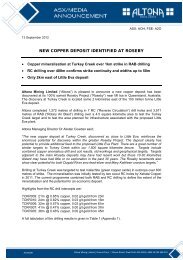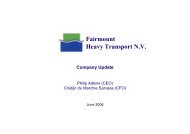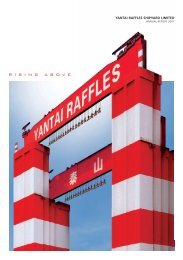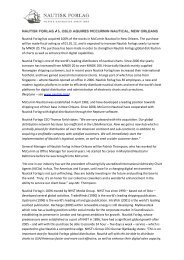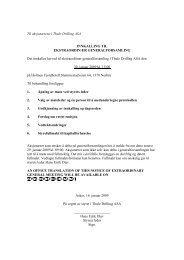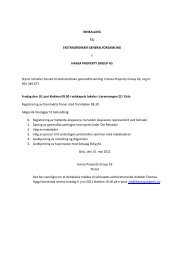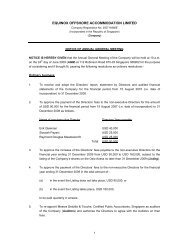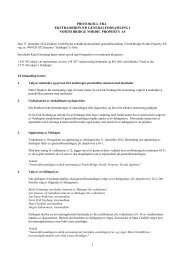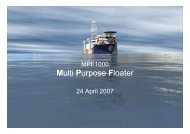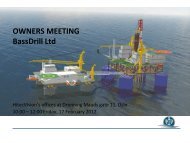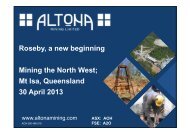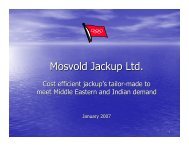Create successful ePaper yourself
Turn your PDF publications into a flip-book with our unique Google optimized e-Paper software.
the lessor) are charged to the income statement on a straight-line basis<br />
over the period of the lease.<br />
Financial leases<br />
Leases in which the company assumes the better part of the risk and<br />
dividend associated with ownership of the asset, are financial leases. At<br />
the beginning of the lease, financial leases are entered at a sum equal to<br />
market value or the present value of the minimum lease sum, whichever<br />
is lower, with accumulated depreciation and write-downs deducted.<br />
When calculating the present value of the lease, the implicit interest rate<br />
cost in the lease is used, if it can be calculated. If not, the company’s<br />
marginal loan interest rate is used. Expenses directly connected to the<br />
establishment of the lease are included in the cost price of the asset.<br />
The depreciation period is the same as for the company’s other depreciable<br />
assets. If there is no reasonable certainty of the company assuming<br />
ownership when the lease expires, the asset is written off over the term<br />
of the lease or for the asset’s financial service life, whichever is shortest.<br />
Operational leases<br />
Lease contracts in which the better part of the risk and dividend in<br />
associated with ownership of the asset are classified as operational<br />
lease contracts. Lease payments are classified as operating costs and<br />
entered using the straight line method over the contract period.<br />
2.20 Capitalisation of borrowing cost<br />
Borrowing costs incurred for the construction of any qualifying asset<br />
are capitalised during the period of time that is required to complete<br />
and prepare the asset for its intended use. Other borrowing costs are<br />
expensed.<br />
Note 3 – Financial risk management<br />
Financial risk factors<br />
The Group’s activities are exposed to a variety of financial risks: market<br />
risk (including currency risk, fair value interest rate risk and price risk)<br />
and credit risk (trade receivables and liquidity risk). The Group’s overall<br />
risk management program focuses on the unpredictability of financial<br />
markets and seeks to minimise potential adverse effects on the Group’s<br />
financial performance. Risk management is carried out by the Finance<br />
Director, together with Senior Management.<br />
Market risk<br />
Market demand for Marine Subsea’s barges and vessels will be driven<br />
by, inter alia, global demand for oil prices for crude oil, actions by OPEC,<br />
worldwide inventory levels, changes in technology, and the availability<br />
and sustainability of competitive fuels. Furthermoremarket demand<br />
for Marine Subsea’s barges and vessels could be impacted by the<br />
actions of competitors, availability of similar vessels, ability of suppliers<br />
and subcontractors to perform on a timely basis or at all under their<br />
agreements, political stability and the actions of governments or other<br />
in the countries and territorial waters of operations.<br />
i) Interest rate risk<br />
Interest rate risk is the risk that the fair value of future cash flows of<br />
a financial instrument will fluctuate because of changes in the market<br />
interest rates. The Group’s exposure to the risk of changes in the market<br />
interest rates relates to the Group’s long-term export credit facilities (Sarah<br />
and Karianne loan) with floating interest rate (e.g. 3 months LIBOR).<br />
However, the latter exposure is offset by the 12 months LIBOR adjustment<br />
incorporated in the MS Sarah Ltd and MS Karianne Ltd Service<br />
Agreements with Sonangol P&P. The exchange bonds are fixed rate.<br />
ii) Foreign exchange risk<br />
Foreign currency risk is the risk that the fair value of future cash flows<br />
of a financial instrument will fluctuate because of changes in foreign<br />
exchange rates. Foreign exchange risk arises from future commercial<br />
transactions, recognized assets and liabilities and net investments in<br />
foreign operations. The Group operates internationally and is exposed to<br />
foreign exchange risk arising from currency fluctuations, primarily NOK/<br />
USD. The future charter income and operating expenses will mainly be<br />
in USD. The remaining commitment to Ulstein Yard for the construction<br />
of the Karianne vessel is hedged through a forward contract to buy NOK<br />
481,8 million and sell USD 83,2 million. The USD will be made available<br />
under the Karianne loan facility upon delivery of the Karianne. At 31st<br />
December 2009, the fair value of this forward contract is deemed to<br />
be of immaterial value. Marine Subsea uses no other derivative financial<br />
instruments to hedge currency risk exposure. The Group’s interest<br />
expenses arise from USD denominated loans.<br />
iii) Commodity price risk<br />
The Group is affected by the volatility of the marine gas oil (MGO)<br />
prices in various areas, with emphasis on the Angolan market. The MGO<br />
prices are historically positively correlated with the oil price. The Group’s<br />
vessels operating activities require a continuous supply of MGO. These<br />
costs are directly covered or fully reimbursed by charterer. The Company<br />
covers the cost of MGO if the vessels go offhire. Currently, the Company<br />
uses no derivative financial instruments to hedge the above mentioned<br />
risk exposures.<br />
iv) Supply rate risk/Contract risk<br />
The profitability and cash flow of Marine Subsea’s operations will be<br />
dependent upon the market conditions for construction support vessels<br />
and well intervention vessels in West Africa. The African Lifter is still<br />
without contract,and African caribe is on a contract ending June 2010,<br />
and African Installer is on a 6 month contract ending in September 2010<br />
without any firm backlog. Current market conditions indicate that the<br />
barges should secure work at levels similar to African Installer’s current<br />
contract, but this cannot be guaranteed.<br />
Credit risk<br />
With reference to the synopsis on the African Challenger project (Marine<br />
Subsea & Consafe) in the <strong>Annual</strong> <strong>Report</strong> 2008, Yantai has agreed to<br />
acquire Consafe MSV AB’s interest in the joint-venture. Yantai has<br />
further agreed to take delivery of African Challenger for its own account<br />
and lease the unit to the JV under a 10-year bareboat lease with<br />
30 Marine Subsea <strong>Annual</strong> <strong>Report</strong> 2009




